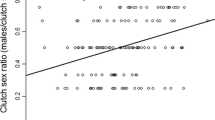Abstract
Male dimorphisms are particularly conspicuous examples of alternative reproductive strategies. The male forceps length dimorphism in the European earwig Forficula auricularia has long been considered an example of a status- (body size) dependent male dimorphism. In this paper, I test three hypotheses relating to the dimorphism of F. auricularia. First, that the dimorphism is status dependent and determined by nutrition. Second, that the dimorphism is a density-dependent adaptation. Third, that there is a genetic basis to population differences in morph frequency seen in the field. These hypotheses were tested by rearing two populations in a split-family rearing design with two diets and two densities. Populations of male earwigs reared in the common garden differed in forceps length and relative forceps length. The populations also differed in the morph frequencies, with 40 versus 26% long-forceped males. These results confirm the notion that there is a genotype-by-environment interaction that determines the morph frequency in a population. There were only minor effects of density on male forceps length and no influence of density on the male dimorphism. In accordance with the hypothesis that the morphs are status-dependent alternatives, large-forceped males only arose on the high-protein diet that produced earwigs of a large body size. However, not all large males produced the long-forceped phenotype. I put forward an extension of the status-dependent dimorphism model that may account for the pattern of forceps dimorphism in this species.
Similar content being viewed by others
Author information
Authors and Affiliations
Additional information
Received: 18 November 1998 / Received in revised form: 14 May 1999 / Accepted: 25 July 1999
Rights and permissions
About this article
Cite this article
Tomkins, J. Environmental and genetic determinants of the male forceps length dimorphism in the European earwig Forficula auricularia L.. Behav Ecol Sociobiol 47, 1–8 (1999). https://doi.org/10.1007/s002650050643
Issue Date:
DOI: https://doi.org/10.1007/s002650050643




